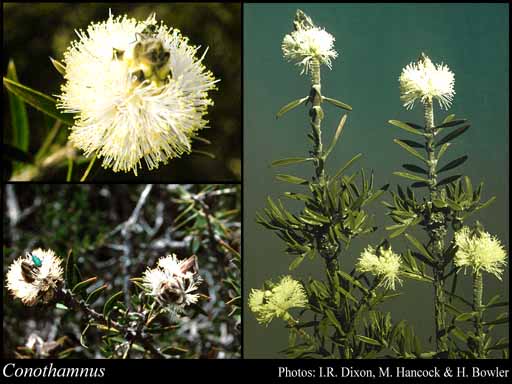- Reference
- Edwards's Bot.Reg. pix. (1839)
- Name Status
- Current

Scientific Description
Family Myrtaceae.
Habit and leaf form. Shrubs; evergreen; bearing essential oils. Plants with neither basal nor terminal concentrations of leaves; to 0.15–1 m high. Leptocaul. Helophytic to xerophytic. Leaves small to medium-sized; opposite; decussate; leathery; subsessile to sessile; connate, or not connate; gland-dotted; aromatic; edgewise to the stem, or with ‘normal’ orientation; simple; epulvinate. Leaf blades dorsiventral, or isobilateral, or centric; entire; flat; linear, or lanceolate, or oblong, or ovate; ovate, or obovate, or oblong, or elliptic; 1 -nerved, or 3 -nerved; pinnately veined, or parallel-veined, or one-veined; cross-venulate, or without cross-venules. Mature leaf blades adaxially glabrous, or pubescent; abaxially glabrous, or pubescent. Leaves without stipules; without a persistent basal meristem. Leaf anatomy. Hairs present, or absent. Stem anatomy. Secondary thickening developing from a conventional cambial ring.
Reproductive type, pollination. Fertile flowers hermaphrodite, or hermaphrodite and functionally male. Unisexual flowers present, or absent. Plants andromonoecious (usually), or hermaphrodite. Entomophilous, or ornithophilous. Pollination mechanism unspecialized.
Inflorescence and flower features. Flowers aggregated in ‘inflorescences’; in heads. Inflorescences simple, or compound. The terminal inflorescence unit cymose. Inflorescences terminal (axis usually dividing into several branches at the apex of the inflorescence after flowering is complete so that the fruits are usually located directly below the point of branching); globular or ellipsoid; with involucral bracts, or without involucral bracts; pseudanthial. Flowers (bi) bracteolate, or ebracteolate; small to medium-sized; regular; 5 merous; cyclic. Free hypanthium present; campanulate; glabrous or pubescent. Hypogynous disk present. Perianth with distinct calyx and corolla, or sepaline; 5, or 10; 1 -whorled, or 2 -whorled; isomerous. Calyx present; 5; 1 -whorled; polysepalous, or gamosepalous (depending on interpretation); imbricate, or valvate; regular. Corolla present, or absent (or not discernible in C. aureus); 5; 1 -whorled; polypetalous; imbricate; regular. Petals elliptic; clawed. Corolla members entire. Androecial members indefinite in number. Androecium 15, or 35–60. Androecial members branched. Androecial sequence determinable, or not determinable. Androecial members if ‘many’, maturing centripetally; free of the perianth; all equal, or markedly unequal; free of one another to coherent (clustered in five groups, each of 3 filaments), or coherent (bundled into staminal claws in C. trinervis); 5 - adelphous. The androecial groups opposite the petals. Stamens 15, or 35–60; becoming exserted (exceeding the petals); alternisepalous; all opposite the corolla members; erect in bud, or inflexed in bud. Anthers all alike; dorsifixed; versatile; dehiscing via longitudinal slits; introrse; tetrasporangiate; appendaged, or unappendaged. Fertile gynoecium present, or absent (male flowers). Gynoecium 3 carpelled. The pistil 3 celled. Gynoecium syncarpous; eu-syncarpous; partly inferior. Ovary plurilocular; 3 locular. Ovary summit hairy, the hairs not confined to radiating bands. Epigynous disk absent. Gynoecium stylate. Styles 1; simple; apical; becoming exserted. Stigmas 1; small. Placentation axile. Ovules 1 per locule; ascending; non-arillate; anatropous.
Fruit and seed features. Fruit non-fleshy; dehiscent; a capsule (3-valved). Capsules loculicidal. Fruit 3 celled; 3 seeded. Seeds 1 per locule. Seeds non-endospermic; ovate or obovate; winged, or wingless. Cotyledons 2.
Geography, cytology, number of species. Native of Australia. Endemic to Australia. Australian states and territories: Western Australia. South-West Botanical Province.
Etymology. From the Greek for "cone" and "bush"; refers to the shape of the flower-head.